Instantly Chat with Your Future Customers in Messenger, Native Web Chat & SMS
Build a Chatbot for:
Mark Zuckerberg Says Messaging is the 'Foundation' of Facebook's Future
“It’s no surprise that the fastest growing ways we’re communicating online are private messaging, and in small groups, and stories.
A private social platform can start to become the center of your social experience.
That’s why I believe that the future is private. This is the next chapter for our services.”
Mark Zuckerberg
Facebook CEO
f8 2019 Developer Conference Keynote
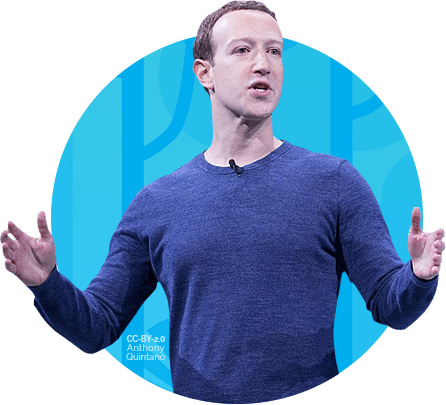
OmniChat Bots work 24/7 in Facebook's 2.3 billion user ecosystem, SMS Messaging & native web chat
Capture, qualify & nurture leads around the clock with an all-in-one Chatbot platform for SMS, Facebook & Web Chat
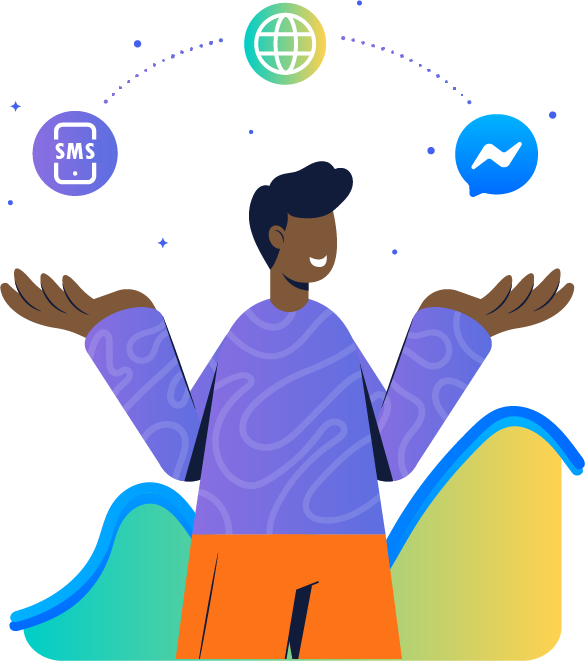
Website chatbots qualify leads and route visitors to the product, team or info they need.
From capturing leads to providing product recommendations, bots do it in an interactive, conversational, on-site chat.
Learn more about these chatbot tools:
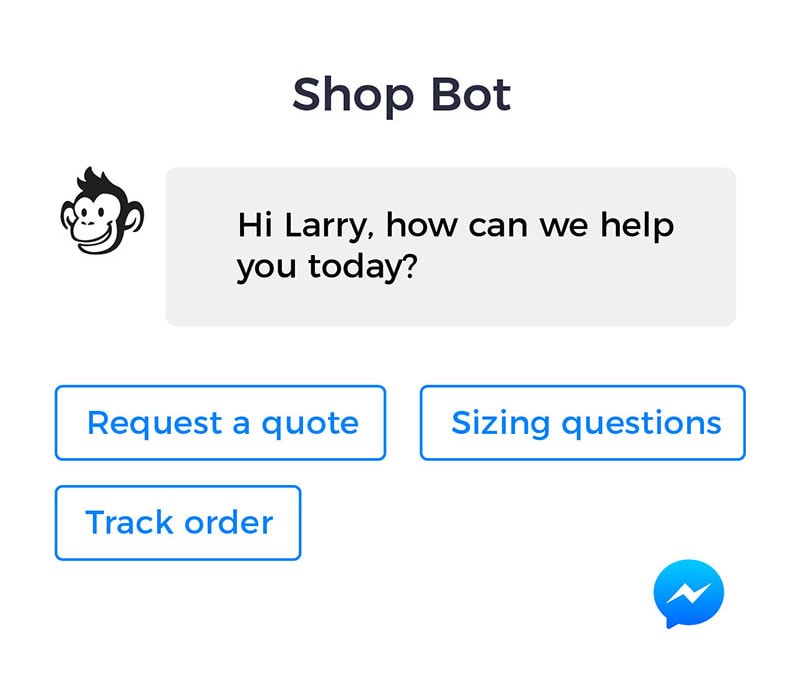
Facebook Messenger chatbots are the only bots that instantly capture lead info on first contact.
Capturing name, location and the ability to send future messages happens before your bot even says “Hi” back.
Learn more about these chatbot tools:
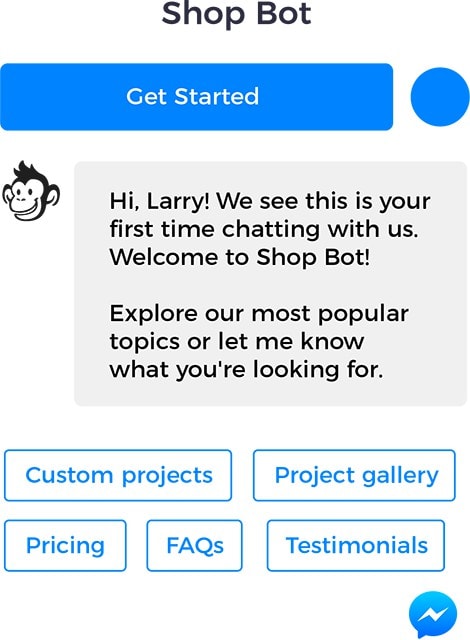
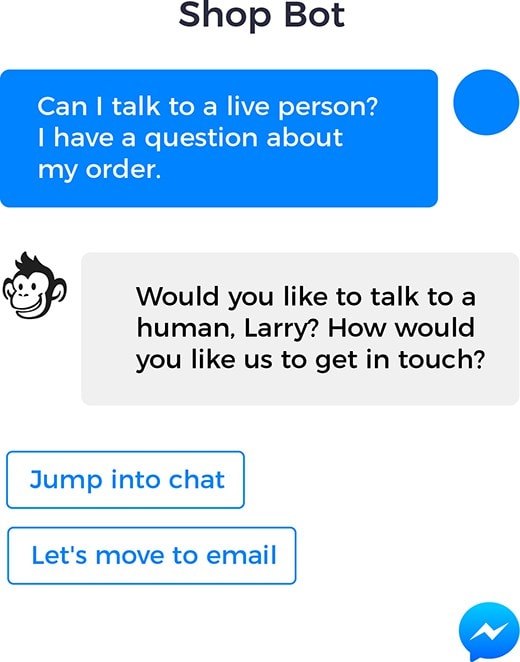
Jump into the conversation at the right time with real-time lead alerts triggered by the bot.
Never miss an opportunity to close a sale with a hot lead alert when a prospect is moving through the funnel.
Learn more about these chatbot tools:
Chatbots provide the ultimate mobile-friendly, cross-device, multi-platform experience.
Customers.ai OmniChat chatbots are always optimized for the device in use by your customers and leads. Messaging history is maintained in one inbox, regardless if customers are chatting in Facebook Messenger or SMS!
Learn more about these chatbot tools:
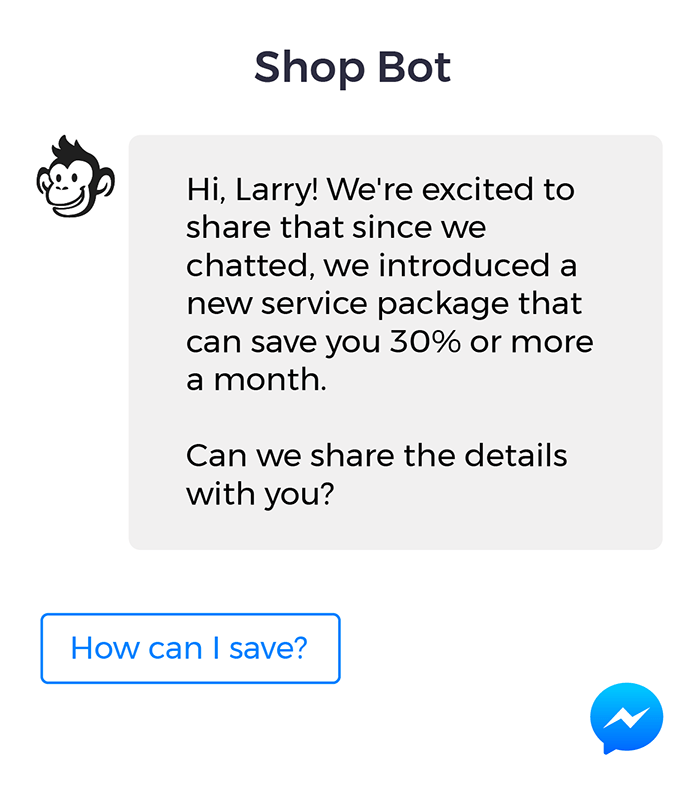
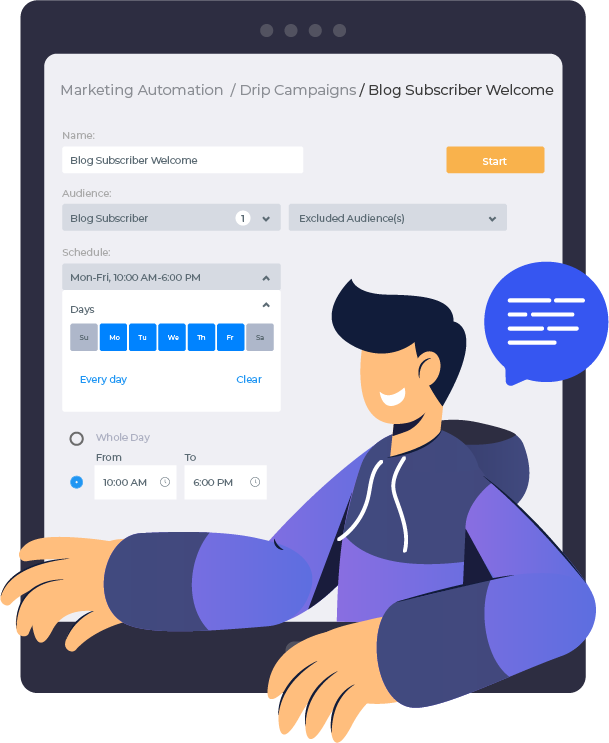
Chat marketing bots are uniquely empowered for continued lead nurture.
Build a chatbot to send follow-up messaging that nurtures leads using segmented campaigns and scheduled sequences.
Learn more about these chatbot tools:
Integrate your marketing stack with instant, 24/7, automatic chatbots that never sleep.
Give your website visitors a virtual assistant that’s plugged into all your business applications, for incredible, time-saving efficiency to your business.
Learn more about these chatbot tools:

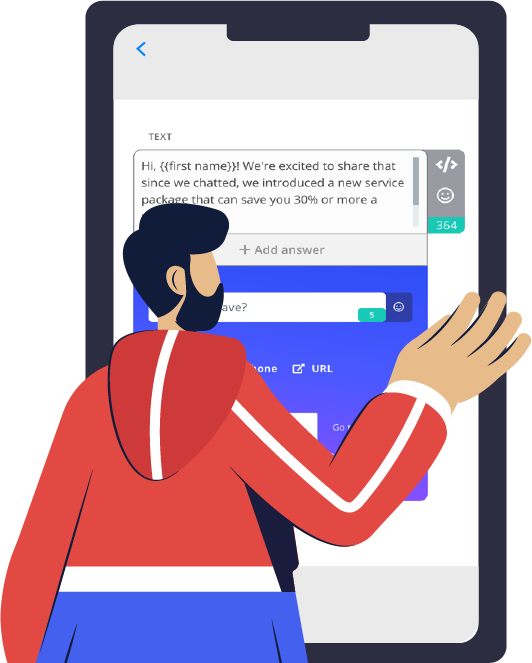
Do it all — design, build and launch chatbot funnels — without writing a line of code.
The easiest chatbot builder features drag-and-drop content widgets and visual campaign tools that work simultaneously across Facebook Messenger and Facebook Ads, SMS and native web chat.
Learn more about these chatbot tools:
See valuable chatbot campaign data and visualizations of bot KPIs.
Get your hands on the data to see top bot campaigns and key metrics, whether you’re an entrepreneur, in-house marketer or agency team.
Learn more about these chatbot tools:
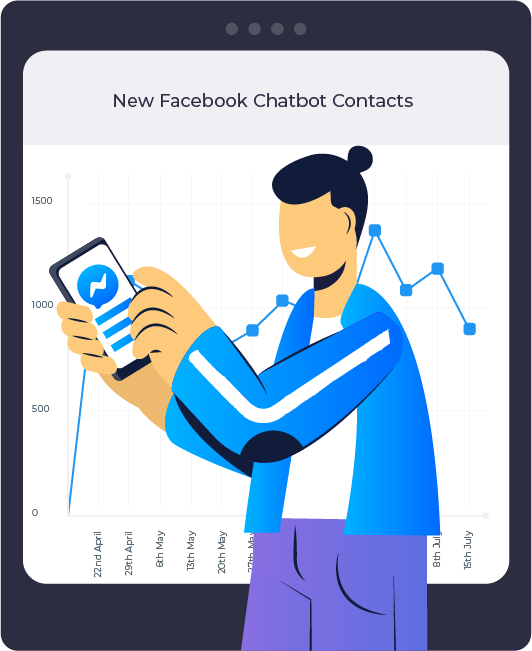
See what people are saying
We have seen great success with Customers.ai over the last several months of implementation. We became ROI positive after only a few weeks of optimizing.

Jesse Perreault
VP of Marketing
Car Loans Canada

Our Facebook ad campaign and sales funnel using Customers.ai bots resulted in revenue over 130K EURO for an ad spend of 300 EURO. That is over 430X of ROAS.

Emmanuel Mantzas
Founder
i-seo.us, Inc.

See the Power of a Customers.ai Chatbot & Free Messenger Marketing Platform
Flexible Plans for Businesses of All Sizes
FOR INDIVIDUALS
Free
WP-PRO Plugin
$49
a year
PRO
Advanced automations & integrations
Starting at
$19
a month
FOR TEAMS
PRO Unicorn
Starting at
$49
a month
Team
Starting at
$129
a month
FOR ENTERPRISE
Let's Chat
Plans for enterprise, multiple teams and large businesses are custom.
Please contact sales@Customers.ai to create a custom plan for your business.
Get Customers.ai OmniChat Marketing Platform Free
Start your free account and add OmniChat multi-channel chat marketing automation to your website today.
Our Customers Love Customers.ai

Chatbot Tools FAQ
What are chatbots?
Chatbots are basically computer programs that can conduct a conversation with a human. Most chatbots today aren’t trying to pose as a real person or pass the Turing test. Instead, they’re used to automate tasks on platforms like Facebook Messenger, SMS messaging, and native website chatbots.
For example, a Customers.ai chatbot can help a user get answers to their frequently asked questions, help someone schedule an appointment, download a digital resource, or sign up for a webinar.
What are OmniChat chatbots?
Customers.ai’s patent-pending OmniChat technology translates chatbots into many popular messaging apps.
Basically, marketers write the conversation flow, lead form, or chatbot integration once.
Then Customers.ai makes that campaign work in Facebook Messenger, SMS message, and native web chat — simultaneously.
OmniChat chatbots triple the reach of chat marketing campaigns without any extra effort by the business owner or marketer creating the campaign.
And leads and customers have the flexibility to use the messaging app that they prefer. Win-win.
What are chatbots used for?
Chatbots are used for marketing, customer service, lead generation, appointment setting, answering FAQs, scheduling appointments, diagnosing a customer’s needs, providing people with directions to a store, showing store hours, asking qualifying questions, providing coupons, conducting surveys, running a contest, and way more.
The question, what are chatbots used for, is honestly kind of hard to answer because chatbot technology is so vast. To get a sense of how chatbots are used, check out these Facebook Messenger chatbots. Each of them is fully functional, so you can play around with the chatbot and get a feel for its functionality.
Of course, all Customers.ai chatbots work in Facebook Messenger, as well as for users who aren’t logged into Facebook Messenger via native web chat.
Are chatbots supposed to simulate human behavior?
Yes and no. chatbots use human-stye dialogue because that’s simply how we interact as humans — questions, answers, words, information, etc. But chatbots aren’t trying pass as a real person. Most of the time, you know you’re interacting with a chatbot. That’s why many bots self-identify as “automated assistant” or some iteration of the name “bot.”
The more natural the language that a chatbot uses and recognizes, the better it works. That’s why many chatbots use Natural Language Processing or NLP programming. NLP allows chatbots to understand the ways that a human will normally communicate, whether that’s in verbal speech or typing. NLP is a function of artificial intelligence (AI) which allows the program to learn from every interaction.
Customers.ai uses NLP with question-and-answer triggers. They are remarkably easy to set up and don’t require any programming skills.
What’s an example of a chatbot?
Here is a chatbot in the Facebook Messenger platform that can answer questions about buying a home, renting a home, or selling a home. You can even view available homes and schedule an appointment to visit one with a realtor. Don’t worry; you’re not actually making an appointment or anything. This chatbot, like many others available on Customers.ai are templates that you can use and customize for your own needs.
Chatbots come in many forms. Siri, Alexa, and Google Assistant are all chatbots. Most website chats are also chatbots, as are the automatic replies you get when you send a message a business on Facebook.
Here’s another example of a fun quiz chatbot that we created for you. The example helps you get a feel for the kind of chatbots you can make.
What is the best chatbot builder?
- Customers.ai – this is the top choice for marketers, businesses, and websites due to its easy-to-use interface, OmniChat multi-channel marketing capabilities, powerful functionality, and low cost (free for most features). You do not need any coding skills to use Customers.ai.
- BotKit – BotKit helps chatbot developers create customer journeys and conversational flows. While it doesn’t actually create chatbots, it helps you visualize and test what your chatbot will do.
- Botsify – This platform is designed to create chatbots that help with customer service issues. It works with Facebook and Slack.
- Botsociety – This platform is a chatbot prototype creator, designed for use with Alexa, Slack, Google Assistant, and Messenger. It does require a deep knowledge of coding.
- ChatterOn – While it doesn’t have the level of features that Customers.ai has, ChatterOn does allow for a code-free chatbot creation process.
- Conversable – Conversable allows for AI-enhanced messaging for many different platforms, including Facebook Messenger, Twitter, and Alexa.
How do you make a chatbot?
- Select a chatbot builder like Customers.ai.
- Connect your chatbot builder to a Facebook Business page.
- Open the chatbot builder and create a dialogue sequence using the drag-and-drop interface.
How much money should businesses spend on chatbots?
If you create chatbots in house, you’ll need to consider the cost of two things:
- Chatbot builder like Customers.ai
- Team members to create the chatbots
Customers.ai has a few pricing points:
- Free
- PRO
- PRO Unicorn
- Team (ideal for agencies)
Take a look at the features included in each plan and pricing here.
As to your operational costs, any of your team members should be able to learn and build simple bots. The process of putting together a bot is quite simple. With no prior chatbot skills, you can build a basic chatbot that works in Facebook Messenger as well as native web chat and SMS in just five minutes. You or anyone else should have a firm grasp of most of Customers.ai’s features and capabilities in an hour or two.
Why don’t more companies use chatbots?
There are 3 main reasons why more businesses aren’t using chatbots:
- Lack of awareness – They aren’t familiar enough with chatbots to know where to begin.
- Unaware of how easy it is – They assume that chatbots are difficult to make (they’re not).
- Assume high cost – They think that chatbots must be expensive to implement or maintain (which they’re not).
Chatbot platforms like Customers.ai have democratized the chatbot building process. Any company can make chatbots that work on many of the messaging apps customers use today, easily and inexpensively.
What is a Messenger chatbot?
A Messenger chatbot is one designed specifically to work on the Facebook Messenger platform. Facebook, which includes WhatsApp, Messenger, and Instagram, now has the largest messaging platform in the world.
Messenger chatbots feature instant lead capture; as soon as a lead messages the Messenger bot, the business receives contact info and default lead qualifying info: first and last name, location, language and gender.
The business can then send automated follow-up messaging that is highly engaging, with chat sequences full of interactivity, images, GIFs, smart responses, downloads, appointment scheduling, contests, updates, quizzes, and more.
Because Messenger is so widely-used and has so much functionality, it is the preferred messaging channel for businesses and marketers today.
However, not all leads and customers are Facebook Messenger users. At that point, Customers.ai chat marketing automations default to native web chat. The native web chat delivers automated messaging to customers that are not signed into Facebook Messenger.
Customers.ai chat marketing automation also simultaneously supports SMS text message marketing campaigns.
What is chatbot marketing?
Chatbot marketing is the use of chatbots to perform marketing tasks.
One common form of chatbot marketing is placing a chatbot on a website so users can ask questions, get information, and engage deeper with the business.
Chatbot marketing using Facebook Messenger is another popular marketing practice. This is often referred to as Messenger marketing or Facebook Messenger marketing. Facebook Messenger marketing is just a specific form of chatbot marketing that uses Messenger as the platform of choice.
Can I make money from chatbots?
Chatbot marketing is the use of chatbots to perform marketing tasks.
Chatbot marketing or chat marketing automation is executing campaigns using messaging as the medium to communicate with leads or customers.
One common form of chatbot marketing is placing a chatbot on a website so users can ask questions, get information, and engage deeper with the business.
Marketers can also send chat marketing campaigns such as chat blasts and drip campaign (timed, automated sequences of messages).
Chatbot marketing can be executed across messaging apps including Facebook Messenger. This is often referred to as Messenger marketing or Facebook Messenger marketing. Facebook Messenger marketing is just a specific form of chatbot marketing that uses Messenger as the platform of communication.
How are chatbots used in marketing?
Chatbots can fulfill marketing functions such as lead generation, lead qualifying, webinar onboarding, answering FAQS, and other standard tasks. With Facebook Messenger chatbots, you can send messages to hundreds of thousands of contacts with a single chatbot.
Chatbots take marketing to a deeper level than, say, email marketing or even paid marketing. For example, Messenger ads combine the power of chatbots with the power of Facebook ads. A Messenger ad is a Facebook ad format in which the user responds to the ad by sending a message.
Sending a message, then, launches a chatbot sequence in Messenger to nurture the user further down the funnel.
Although chatbot marketing has massive potential, surprisingly few businesses are using it. One possible explanation for the slow uptake is that marketers may not realize how easy it is to create a chatbot. Customers.ai is pioneering change in the chatbot marketing space in order to allow more businesses to use the power of chatbots with ease and low expense.
Who is making all these chatbots?
Chatbots can fulfill marketing functions such as lead generation, lead qualifying, webinar onboarding, answering FAQS, and other standard tasks. With chatbots, you can send messages to hundreds of thousands of contacts with a single campaign. With Customers.ai, those campaigns can be sent to contacts across messaging applications including SMS and Facebook Messenger simultaneously.
Chatbots take marketing to a deeper level than, say, email marketing or even paid marketing. For example, Messenger ads combine the power of chatbots with the power of Facebook ads. A Messenger ad is a Facebook ad format in which the user responds to the ad by sending a message.
Sending a message, then, launches a chatbot sequence in Messenger to nurture the user further down the funnel.
Although chatbot marketing has massive potential, surprisingly few businesses are using it. One possible explanation for the slow uptake is that marketers may not realize how easy it is to create a chatbot. Customers.ai is pioneering change in the chatbot marketing space in order to allow more businesses to use the power of chatbots with ease and low expense. Customers.ai’s unique OmniChat chat marketing campaigns increase campaign reach and efficiency by allowing businesses to send campaigns that work in multiple messaging apps at once.
Why are chatbots so important?
Chatbots are highly significant because they are taking over tasks and interactions that would otherwise require human interaction. According to Business Insider, 80% of all businesses will be using some form of chatbots by 2020.
A chatbot is available 24/7, whereas around-the-clock service by humans would be costly and complicated. Chatbots can easily handle transactional tasks such as scheduling, providing answers to simple questions, ordering products, coordinating deliveries, collecting information, etc.
Chatbots are an enormously powerful marketing tool because they allow for one-to-one interaction at scale. A chatbot interacts with one user, giving that user a personalized and interactive experience. But because a chatbot is 100% automated, it can be having similar interactive conversations with hundreds of thousands of people simultaneously.
This is one of the reasons why chatbot marketing has become such a hot topic for today’s marketing community. Marketers are beginning to understand how a simple chatbot can help them to get leads, attract customers, and increase revenue.
What is a chatbot agency?
Is it easy to make a chatbot?
A chatbot agency is a marketing agency that creates and chatbots for their customers. Selling chatbot services is a smart business move for marketing agencies that are already involved in Facebook marketing, email marketing, or PPC in some way.
Creating chatbots can be a value-added upsell for businesses that run Facebook ads or automation campaigns. Many agencies are opting to broaden their service to include chatbots as part of their standard suite of offerings. If you own or work for a marketing agency, it would be wise to consider adding chatbot marketing to your services.
Marketing consultants are similar to agencies in that they provide chatbot marketing services or consulting to their clients.
If you are a chatbot agency or consultant, please be sure to get listed on the Customers.ai Certified Agency Directory.
Do chatbots integrate with other technologies?
Of course! Chatbot integration is virtually limitless. Customers.ai is a Zapier Integration Partner.
Are Siri, Mitsuku, and Alexa chatbots?
Yes. Siri, Mitsuku, and Alexa are all chatbots, along with Google Assistant, Cortana, and Bixby. Chatbots appear in many other places. For example, Hipmunk is a chatbot that allows you to plan your next trip. National Geographic has a chatbot that simulates a conversation with Albert Einstein. WholeFoods has a Messenger chatbot that helps you find a recipe that you’ll like. And DuoLingo lets you hone your foreign-language skills with a chatbot in the language of your choice.
How long does it take to make a chatbot?
It can take from five minutes to hundreds of hours to make a chatbot. The difference is in whether or not you use a chatbot builder, what platform you choose, and what you want the chatbot to do.
With Customers.ai, it takes only a few minutes to set up a fully-functional interactive chatbot. That’s because most of the work has been done for you already.
If you were to create a more complex chatbot on Customers.ai — perhaps one that segmented users into specific audiences and funneled select audiences to a webinar schedule — that could take a couple of hours.
If you have the coding skills (and the time), you can even create a chatbot from the absolute ground up using, you should plan to invest dozens of hours.
What is an AI-powered chatbot?
It can take from five minutes to hundreds of hours to make a chatbot. The difference is in whether or not you use a chatbot builder, what platform you choose, and what you want the chatbot to do.
With Customers.ai, it takes only a few minutes to set up a fully-functional interactive chatbot that works in Facebook Messenger, native web chat and SMS. That’s because most of the work has been done for you already.
If you were to create a more complex chatbot on Customers.ai — perhaps one that segmented users into specific audiences and funneled select audiences to a webinar schedule — that could take a couple of hours.
If you have the coding skills (and the time), you can even create a chatbot from the absolute ground up using, you should plan to invest dozens of hours.
How much does it cost to build a chatbot?
The price can range from $0 to thousands of dollars. Customers.ai is free, and you can have a fully-functional chatbot without spending any money.
For a full suite of powerful features and advanced functionality, Customers.ai plans start at less than $50 per month.
How do you make a Facebook chatbot?
Here is how to build a Facebook chatbot in 6 steps:
- Step 1: Create a Customers.ai account (it’s free)
- Step 2: Connect your Facebook Business Page to Customers.ai
- Step 3: Open up the Customers.ai Bot Builder
- Step 4: Click Add Widget to create dialogues, forms, Gifs, galleries, quick questions, or any of the 15 widgets available
- Step 5: Continue with any additional chatbot elements
- Step 5: When complete, click Test Dialogue to see what it looks like in Facebook Messenger
- Step 6: Copy the link and use the chatbot wherever you’d like to
Depending on the complexity and features of your chatbot, you can have a complete and robust chatbot in five minutes or less.
What is a Facebook chatbot?
Here is how to build a Facebook chatbot in 6 steps:
- Step 1: Create a Customers.ai account (it’s free)
- Step 2: Connect your Facebook Business Page to Customers.ai
- Step 3: Open up the Customers.ai Bot Builder
- Step 4: Click Add Widget to create dialogues, forms, Gifs, galleries, quick questions, or any of the 15 widgets available
- Step 5: Continue with any additional chatbot elements
- Step 5: When complete, click Test Dialogue to see what it looks like in Facebook Messenger
- Step 6: Copy the link and use the chatbot wherever you’d like to
Depending on the complexity and features of your chatbot, you can have a complete and robust chatbot in five minutes or less. Customers.ai Facebook chatbots also work for users who are not signed into Facebook thanks to OmniChat native web chat support.
Are chatbots the future?
Chatbots are the future and the present. Already, hundreds and thousands of businesses are using chatbots to automate tasks and to facilitate easy interaction. Most businesses use chatbots for their marketing power — drip campaigns, Messenger ads, quizzes, autoresponders, etc. Innovative chatbots include those that help you pick a Netflix movie to watch, recommend a recipe to try out, or help you know when your baby is ready for solid food.
Chatbots have been around since the 1990s, but in the past four years, they have become mainstream. Many people have chatbot devices sitting on their desks or in their pockets. Many of us interact with chatbots on a daily basis, whether we’re placing an order or setting an appointment.
Yes, chatbots are the future, in that they will continue to evolve and improve. But they are also the present, because of their current preponderance in our everyday lives.
What companies use chatbots?
Most major companies use chatbots in some way, including CocaCola, Whole Foods, Amazon, etc. These companies use chatbots in a huge variety of ways, from internal services for their employees, to engaging new leads.
What many people don’t realize is that even tiny companies — a mom and pop store or a solopreneur marketer — are also using chatbots. Making a marketing chatbot is so easy, and it takes just a few minutes to set up.
Many companies, both large and small, choose Customers.ai to create chatbots because it’s easy to use and doesn’t cost anything (although you can upgrade to a paid account.)
Chatbots are no longer just for big companies with an R&D department and huge budget. Chatbots are for any company that wants to improve their marketing, save time, and earn more revenue.
How do I add a chatbot to my website?
One of the most popular methods for chatbot use is placing a chatbot on a website. A website chat widget allows customers to ask questions, get information, and become leads.
Here is how to set up a chatbot on your WordPress website:
- Install WP-Chatbot from the plugins page
- Create a Customers.ai account
- Connect your Facebook account to your chatbot
- Confirm your settings
What industries are chatbots used in?
Most major companies use chatbots in some way, including CocaCola, Whole Foods, Amazon, etc. These companies use chatbots in a huge variety of ways, from internal services for their employees, to engaging new leads.
What many people don’t realize is that even tiny companies — a mom and pop store or a solopreneur marketer — are also using chatbots. Making a marketing chatbot is so easy, and it takes just a few minutes to set up.
Many companies, both large and small, choose Customers.ai to create chatbots because it’s easy to use, chat marketing campaigns work on multiple popular messaging apps, and Customers.ai doesn’t cost anything (although you can upgrade to a paid account).
Chatbots are no longer just for big companies with an R&D department and huge budget. Chatbots are for any company that wants to improve their marketing, save time, and earn more revenue.
What can OmniChat chatbots do?
Here is a list of chatbot capabilities that can be executed on messaging apps including Facebook Messenger, SMS and native web chat:
- Provide a survey (e.g., for customer satisfaction or anything else)
- Give users a quiz
- Show a slideshow of images
- Schedule an appointment
- Sign up for an event
- Get a coupon
- Segment into a specific user group
- Place an order — food from a restaurant or an ecommerce product for sale
- Check the weather
- Automatically update subscribers with new blog articles
- Provide information on specific products or services
- Request information from a user (e.g., email address, phone number)
- Answer basic questions about the business
- Switch to a live operator to take over the chat
A simple bullet list of capabilities really doesn’t give you the big picture. In order to understand the true capabilities of chatbots, it’s more helpful to view them in light of a specific use case.
Let’s use a dentist office as an example. What can a chatbot do in the context of a dentist?
- Patients can schedule appointments
- Patients can get directions to the office
- Patients can get information on office hours
- Patients can get detailed information on what services are available at the dentist’s office
- Patients can sign up for the mailing list
- Patients can enter for a chance to win a free teeth cleaning
- Patients can learn more about the doctors or technicians who work at the office, complete with pictures or videos
- Patients can get information about how to prepare for their cleaning, extraction, or other dental service
Check out chatbot case studies to find out more details on what chat marketing campaigns can do.
Can you stump a chatbot?
Of course.
Many chatbots in use today, for example a chatbot for a dentist’s office, are designed to work in a limited context for a specific purpose. If someone types in a question that the chatbot can’t answer, then the chatbot will explain why it can’t answer it, and invite the user to submit a question or allow a human to reply.
Customers.ai has a feature that allows a user to switch to live chat with a human if they prefer. This way, any questions or issues that the chatbot can’t service, a human should be able to solve.
Okay, so there are chatbots that are trained and developed specifically for the purpose of carrying on conversations with humans. Developers work hard to program the chatbots in such a way that they carry on with conversational ease (albeit a bit awkward) if they encounter something that may be unfamiliar.
Will chatbots take over the world?
No, however, there is a theory that one day artificial intelligence will take control of the world, effectively removing power from the human species. It’s called the singularity or AI takeover.
Creating a few more chatbots, even AI chatbots, won’t do much to speed the obliteration of the human species.
Can you sell chatbots?
Yes. More specifically, you can sell chatbot services, which usually involves creating chatbots and servicing them.
Often, it’s marketing agencies that are in the best position to sell chatbot services. Agencies, especially marketing agencies in the digital ad or Facebook space, can dramatically boost revenue, high-ticket retainers, and valuable clients by offering chatbots as part of their services.
What are some hacks for improving my chatbot-making skills?
Two things will exponentially improve your chatbot prowess.
First, keep making chatbots as often as possible. The more you make and experiment with chatbots, the more you’ll improve. Don’t be afraid to push yourself by trying new stuff.
Second, attend webinars, pay for classes, and read as much as you can. Although chatbots are a relatively recent marketing trend, there is a lot of information available on the subject. Customers.ai’s Learning Center is a centralized chatbot marketing resource center, making it easy for you to get best-of-class education on chatbots and marketing. Keep tabs on this resource, since Customers.ai often hosts growth summits and virtual conferences.
Third, become part of chatbot groups. Customers.ai’s Facebook group is a place where thousands of chatbot creators and marketers work together to share ideas, get help, provide feedback, and stay up to speed on chatbot marketing trends.
Aren’t humans better than chatbots?
It depends on the context, of course.
The State of Chatbots Survey from Salesforce indicated that 69% of customers prefer interacting with a chatbot. The data also indicates that consumers feel that chatbots are better at answering most types of questions than humans are.
Chatbots perform better than humans on formulaic and repetitive tasks. Something like requesting an email address, is simple and virtually error-free when using a chatbot. A survey chatbot or quiz chatbot is an excellent way to make use of the automated capabilities and chatbot technology.
For many purposes, though, it’s better to interact with a human. Customers.ai’s live takeover feature makes it easy for a lead, client, or customer to request a human to step into the chat. At that point, a real person can join the chat and help the customer.
Chatbots do a lot to reduce human workload. A few well-designed chatbots can effectively do the work of 5 or 10 full-time people. This saves companies a lot of time and cost.
And Customers.ai chatbots do a lot to reduce the marketer’s workload but increasing the reach and efficiency of chat marketing campaigns so that they work simultaneously across messaging apps.
What do people expect from chatbots?
When considering the benefit of interacting with chatbots, customers are looking for speed and convenience. The State of Chatbots report revealed that the top three consumer expectations of chatbots were
- Quick answers to simple questions
- 24-hour service
- Convenience
How quickly should a chatbot respond?
Chatbots are designed to respond instantly. There are some situations in which you might want to build in a few second delay to simulate the cadence of a human interaction. In these cases, you can program the chat to show that it’s typing for a short time. To use this feature in Customers.ai, you simply drag and drop the typing widget and adjust the time.
How do chatbots save money for businesses?
Chatbots save money by reducing the costs associated with human labor. One chatbot research report estimates that chatbots could save 390 billion in U.S. customer service costs.
Chatbots also serve as powerful lead magnets. Clients and customers can interact with the chatbot, which seamlessly guides them through the sales funnel.
Chatbots can help with scheduling as well. Often, making appointments or setting up calls can be time-consuming and tricky. Chatbots automate this process, making scheduling a cinch.
